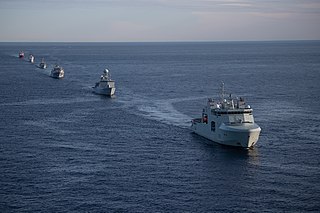Related Research Articles

The Royal Norwegian Navy is the branch of the Norwegian Armed Forces responsible for naval operations of Norway, including those of the Norwegian Coast Guard. As of 2008, the Royal Norwegian Navy consists of approximately 3,700 personnel and 70 vessels, including 4 heavy frigates, 6 submarines, 14 patrol boats, 4 minesweepers, 4 minehunters, 1 mine detection vessel, 4 support vessels and 2 training vessels.

The Canadian Armed Forces are the unified military forces of Canada, including land, sea, and air commands referred to as the Canadian Army, Royal Canadian Navy and the Royal Canadian Air Force. Under the National Defence Act, the Canadian Armed Forces are an entity separate and distinct from the Department of National Defence, which also exists as the civilian support system for the forces.

The Royal Canadian Navy is the naval force of Canada. The navy is one of three environmental commands within the Canadian Armed Forces. As of February 2024, the RCN operates 12 Halifax-class frigates, 12 Kingston-class coastal defence vessels, 4 Victoria-class submarines, 4 Harry DeWolf-class offshore patrol vessels, 8 Orca-class patrol vessels, and several auxiliary vessels. The RCN consists of 8,400 Regular Force and 4,100 Primary Reserve sailors, supported by 3,800 civilians. Vice-Admiral Angus Topshee is the commander of the Royal Canadian Navy and chief of the Naval Staff.

The McDonnell Douglas CF-18 Hornet is a Royal Canadian Air Force (RCAF) variant of the American McDonnell Douglas F/A-18 Hornet fighter aircraft. In 1980, the F/A-18 was selected as the winner of the New Fighter Aircraft Project competition to replace CF-104 Starfighter, CF-101 Voodoo and the CF-116 Freedom Fighter. Deliveries of the CF-18 to the Canadian Armed Forces began in 1982. CF-18s have supported North American Aerospace Defense Command (NORAD) air sovereignty patrols and participated in combat during the Gulf War in 1991, the Kosovo War in the late 1990s, and as part of the Canadian contribution to the international Libyan no-fly zone in 2011. CF-18s were also part of the Canadian contribution to the military intervention against ISIL, Operation Impact. A procurement process to replace the CF-18 with the Lockheed Martin F-35 Lightning II has been ongoing since 1997.

The Distant Early Warning Line, also known as the DEW Line or Early Warning Line, was a system of radar stations in the northern Arctic region of Canada, with additional stations along the north coast and Aleutian Islands of Alaska, in addition to the Faroe Islands, Greenland, and Iceland. It was set up to detect incoming bombers of the Soviet Union during the Cold War, and provide early warning of any sea-and-land invasion.

The Royal Canadian Air Force is the air and space force of Canada. Its role is to "provide the Canadian Forces with relevant, responsive and effective airpower". The RCAF is one of three environmental commands within the unified Canadian Armed Forces. As of 2020, the Royal Canadian Air Force consists of 12,074 Regular Force and 1,969 Primary Reserve personnel, supported by 1,518 civilians, and operates 258 manned aircraft and nine unmanned aerial vehicles. Lieutenant-General Eric Kenny is the current Commander of the Royal Canadian Air Force and Chief of the Air Force Staff.

The South African National Defence Force (SANDF) comprises the armed forces of South Africa. The Chief of the SANDF is appointed by the President of South Africa from one of the armed services. They are in turn accountable to the Minister of Defence and Military Veterans of the Defence Department.

Sealift is a term used predominantly in military logistics and refers to the use of cargo ships for the deployment of military assets, such as weaponry, vehicles, military personnel, and supplies. It complements other means of transport, such as strategic airlifts, in order to enhance a state's ability to project power.
The Protecteur class of naval auxiliaries for the Royal Canadian Navy (RCN) began as the Joint Support Ship Project, a Government of Canada procurement project for the RCN that is part of the National Shipbuilding Procurement Strategy. It will see the RCN acquire two multi-role vessels to replace the earlier Protecteur-class auxiliary oiler replenishment vessels.
A joint support ship (JSS) is a multi-role naval vessel capable of launching and supporting joint amphibious and airlift operations. It can also provide command and control, sealift and seabasing, underway replenishment, disaster relief and logistics capabilities for combined land and sea operations.
The Amphibious Assault Ship Project was a proposed procurement project by the Government of Canada for the Royal Canadian Navy (RCN). However, no such project was incorporated into the Government's defence plan Strong, Secure and Engaged released in 2017 and cost challenges with other naval procurement projects under the National Shipbuilding Procurement Strategy has led to no movement on the idea.

Defence Equipment and Support (DE&S) is a trading entity and joint-defence organisation within the UK Ministry of Defence. It began operating on 2 April 2007, following the merger of the MoD's Defence Procurement Agency and the Defence Logistics Organisation, under the Chief Executive Officer of Defence Equipment and Support.

The New Fighter Aircraft Project (NFA) was a Government of Canada defence procurement project undertaken in the late 1970s that saw the Department of National Defence (DND) select a single new fighter jet to replace the fleets of CF-101 Voodoo, CF-104 Starfighter and CF-116 Freedom Fighter aircraft in the Canadian Forces.

Harry DeWolf-class offshore patrol vessels are warships of the Royal Canadian Navy (RCN) built within the Government of Canada Arctic and Offshore Patrol Ship (AOPS) procurement project, part of the National Shipbuilding Strategy. In July 2007 the federal government announced plans for acquiring six to eight icebreaking warships for the RCN.

Operation Nanook is an annual sovereignty operation and manoeuvre warfare exercise conducted by the Canadian Armed Forces in the Arctic. Sovereignty patrols in the Canadian Arctic Archipelago and northern Canada are conducted by the Canadian Rangers, Canadian Coast Guard in tandem with the Royal Canadian Mounted Police. The exercise portion is intended to train the different elements of the Canadian Armed Forces to operate in the Arctic environment.
List of future or planned Canadian Armed Forces projects.
The National Security Strategy and Strategic Defence and Security Review 2015 was published by the British government during the second Cameron ministry on 23 November 2015 to outline the United Kingdom's defence strategy up to 2025. It identified key threats to the UK and the capabilities it required to address them.

Anita Indira Anand is a Canadian lawyer and politician who has served as the Minister of Transport and Internal Trade since 2024. She has represented the riding of Oakville in the House of Commons since the 2019 federal election, sitting as a member of the Liberal Party.

Operation Broadshare is the code name for the British military operation to address the COVID-19 pandemic overseas, primarily in the British Overseas Territories (BOTs) and British overseas military bases. The operation runs in parallel to a similar military operation in the United Kingdom, named Operation Rescript.
References
- 1 2 3 "ARCHIVED - Canada First Defence Strategy - Complete document". Department of National Defence. 2013-02-19. Archived from the original on 2019-02-05. Retrieved 2021-04-15.
- ↑ "ARCHIVED - Canada First Defence Strategy - Summary". Department of National Defence. 2013-03-06. Archived from the original on 2019-02-04. Retrieved 2021-04-15.
- ↑ Wood, Andrew. "Canada, the Freeloader, Rather Than Vested Defence Partner in NORAD and the Defence of North America" (PDF). Canadian Military Journal. 21 (2): 5–13. Retrieved 2021-11-14.
- ↑ "SECTION II: Analysis of Program Activities by Strategic Outcome". National Defence and the Canadian Armed Forces. Government of Canada. 26 March 2009. Retrieved 21 October 2014.
- ↑ Department of National Defence (2018-12-13). "Fixed-wing search and rescue procurement project". Canada.ca. Retrieved 2021-11-14.